Abstract
The aim of the present study was to investigate whether corpuscular immune complexes containing human IgA were able to interact with human polymorphonuclear leucocytes (PMN). As a model for corpuscular IgA immune complexes (IgA IC), heat-killed Staphylococcus aureus (S. aureus) opsonized with either purified human serum IgA or purified secretory IgA (sIgA) isolated from human colostrum was used. In order to determine the capacity of IgA and sIgA to opsonize S. aureus the phagocytosis of these IgA IC by PMN was measured. S. aureus opsonized with IgA, sIgA, IgG, heat-inactivated serum or fresh serum was ingested by 23 +/- 8%; 28 +/- 9%; 39 +/- 7%; 31 +/- 10% and 78 +/- 10% of the PMN (S. aureus:PMN = 10:1, n = 4), respectively. These results were significantly different (P less than 0.05) from the percentage obtained with unopsonized S. aureus (9 +/- 3%), indicating that IgA and sIgA induce ingestion of S. aureus. The phagocytic index for PMN incubated with S. aureus opsonized with sIgA (231) was higher than for S. aureus opsonized with IgA (119), indicating a better uptake of S. aureus opsonized with sIgA in our system. Bacteria opsonized with either IgA or sIgA were also capable of triggering H2O2 release of PMN in a dose-dependent manner. The H2O2 release by PMN triggered with S. aureus opsonized with IgA could not be inhibited with a F(ab')2 anti-Fe gamma receptor monoclonal antibody, whereas the H2O2 release triggered with S. aureus opsonized with IgG was fully inhibited. Soluble heat-aggregated IgA (AIgA) also induced H2O2 release of PMN, suggesting that the IgA itself is essential for the induction of a respiratory burst.
Full text
PDF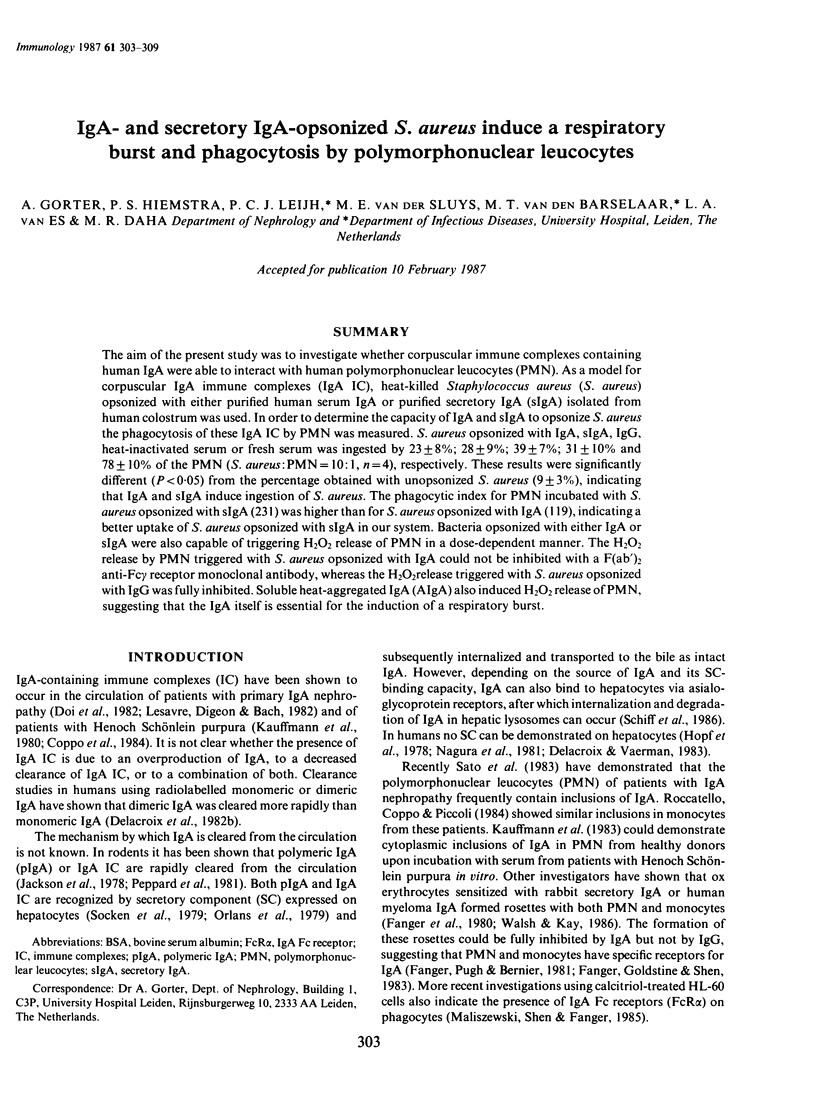
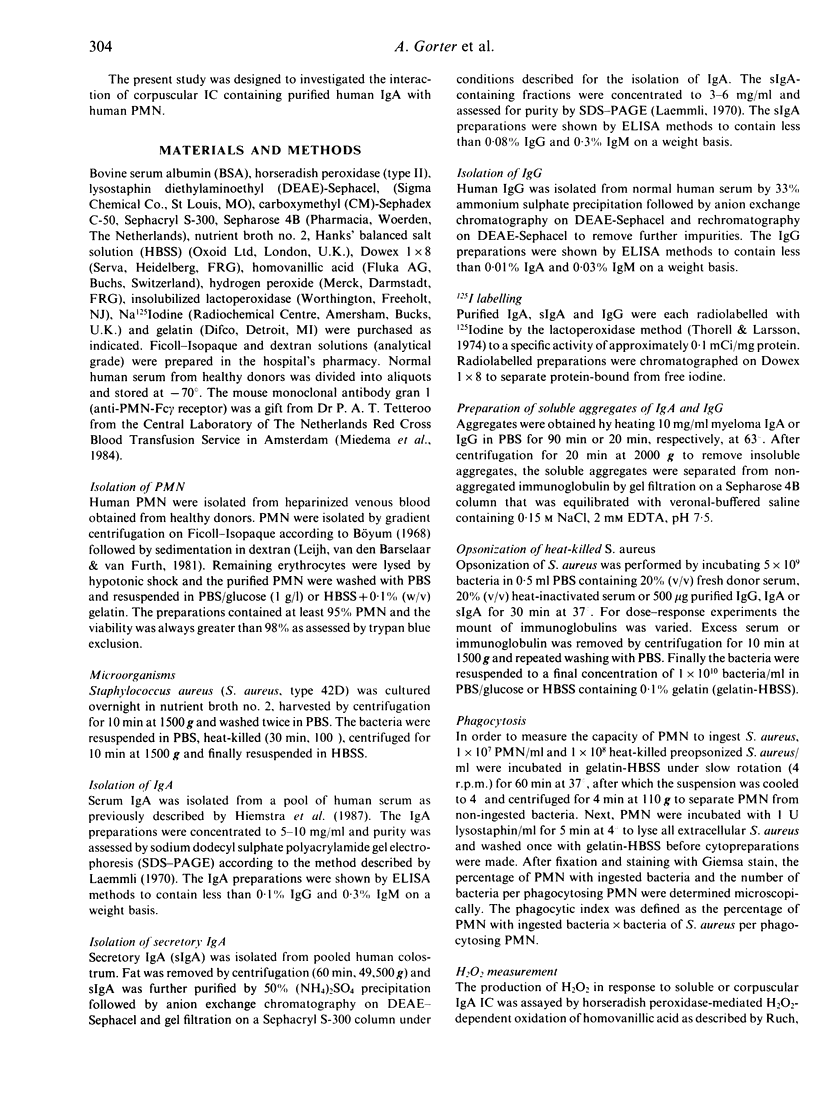
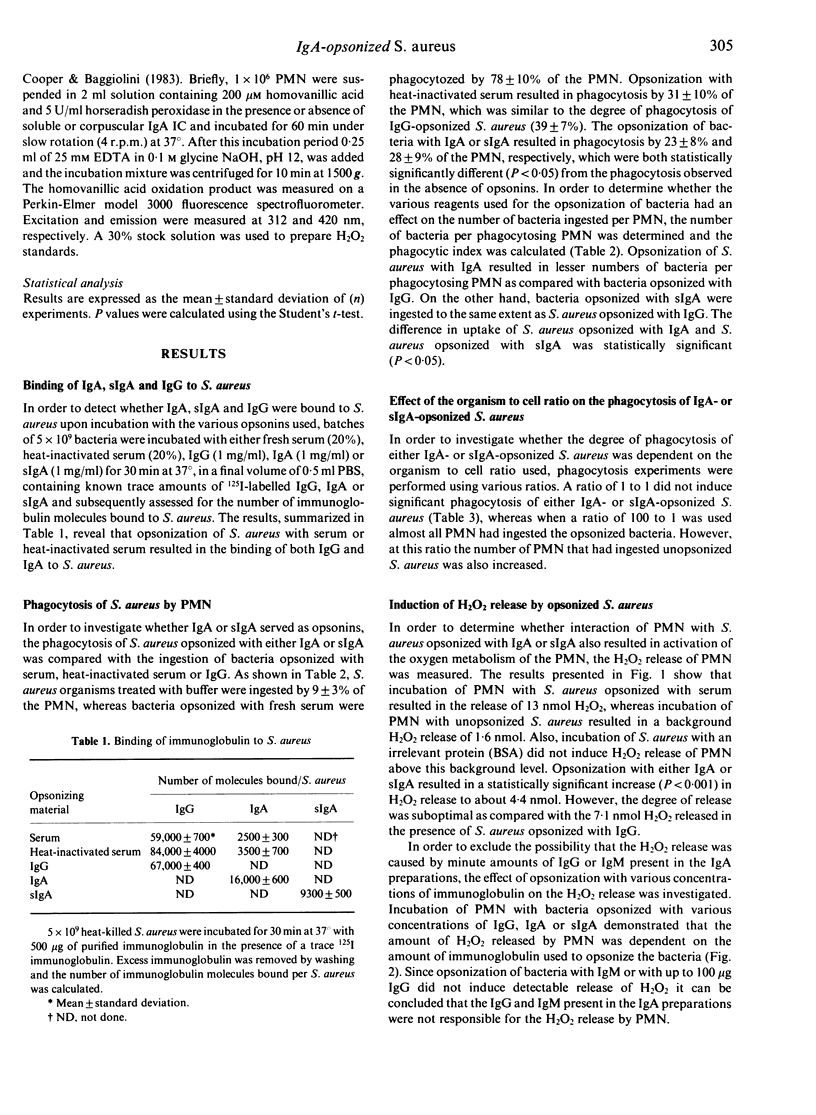

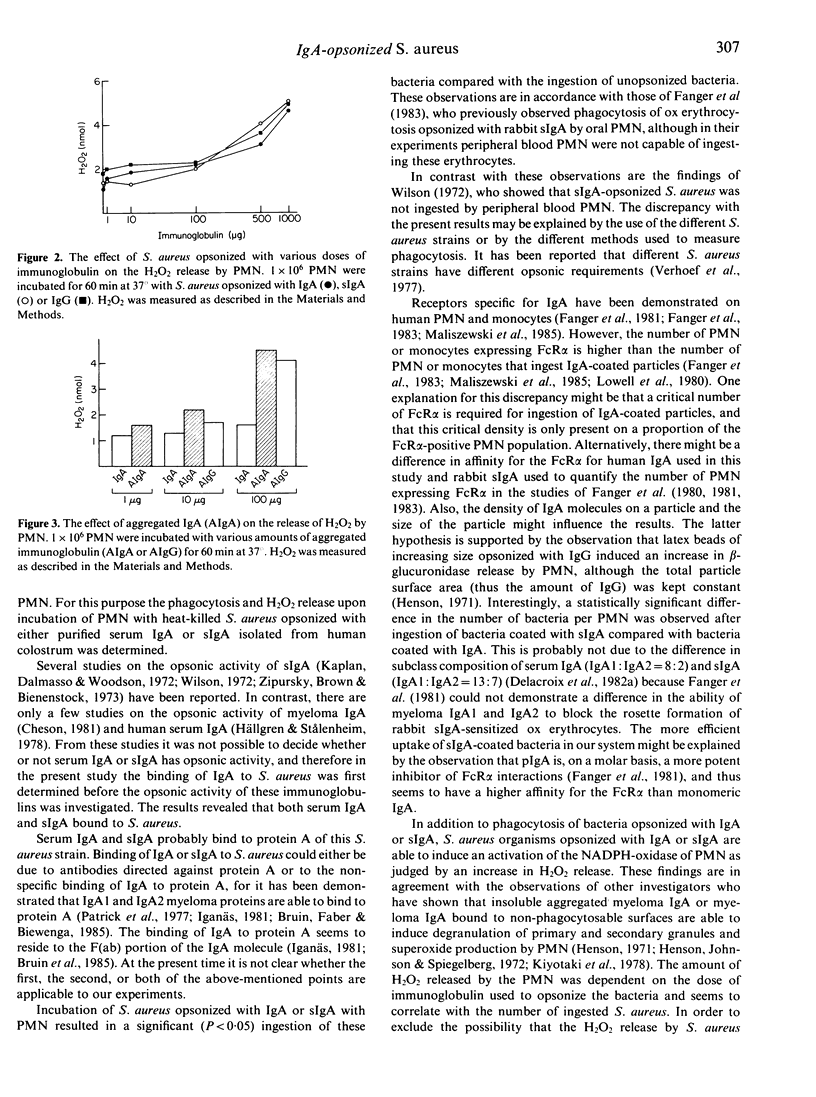
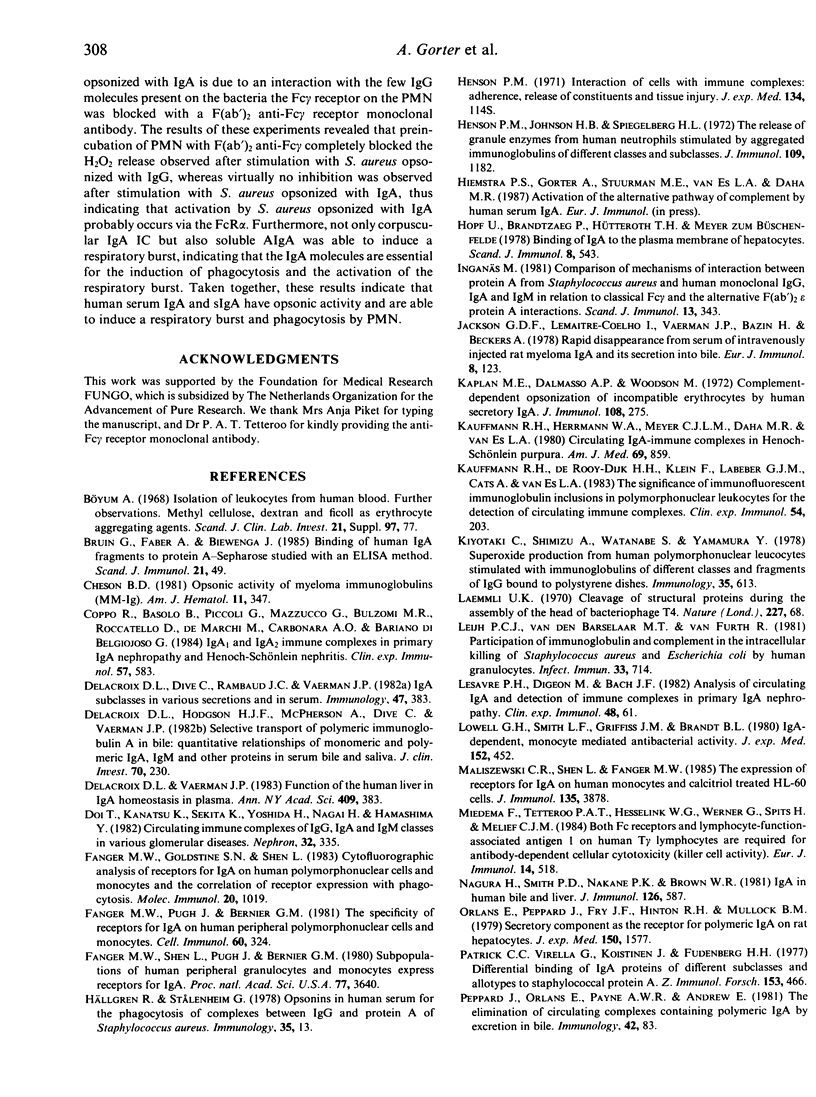
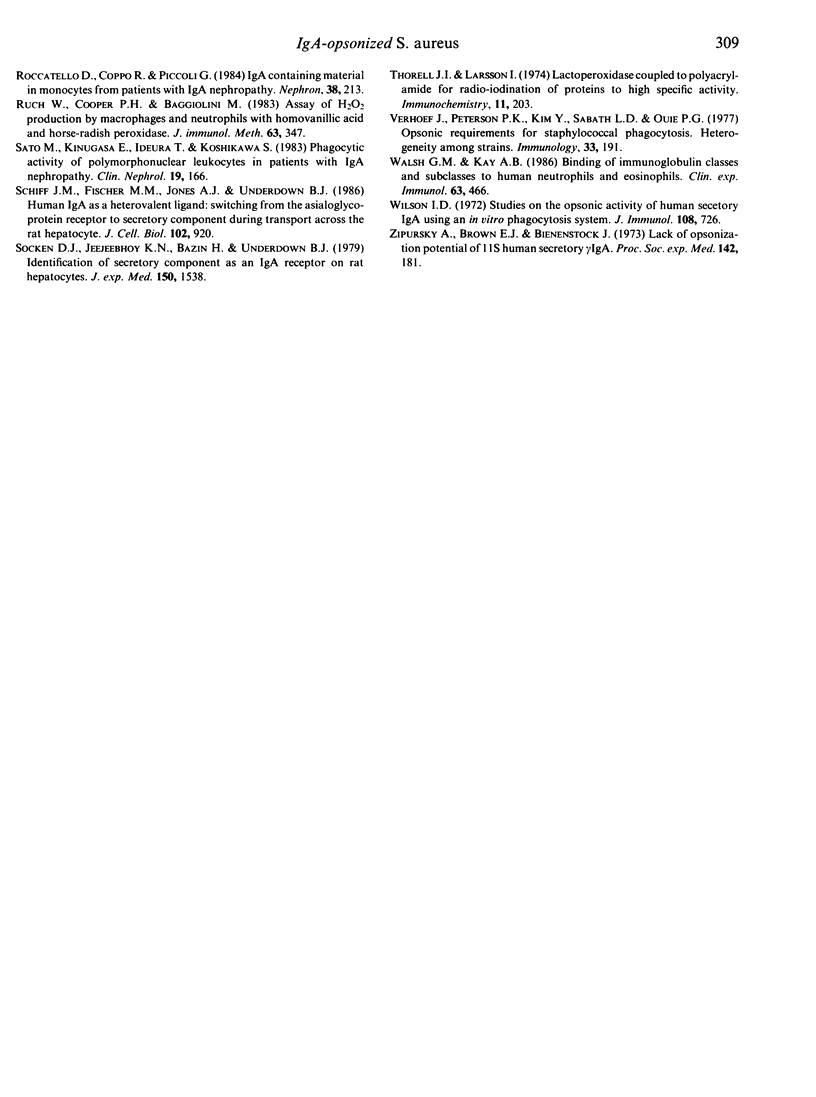
Selected References
These references are in PubMed. This may not be the complete list of references from this article.
- Bruin G., Faber A., Biewenga J. Binding of human IgA fragments to protein A-Sepharose studied with an ELISA method. Scand J Immunol. 1985 Jan;21(1):49–54. doi: 10.1111/j.1365-3083.1985.tb01402.x. [DOI] [PubMed] [Google Scholar]
- Cheson B. D. Opsonic activity of myeloma immunoglobulins (MM-Ig). Am J Hematol. 1981 Dec;11(4):347–353. doi: 10.1002/ajh.2830110403. [DOI] [PubMed] [Google Scholar]
- Coppo R., Basolo B., Piccoli G., Mazzucco G., Bulzomì M. R., Roccatello D., De Marchi M., Carbonara A. O., Barbiano di Belgiojoso G. IgA1 and IgA2 immune complexes in primary IgA nephropathy and Henoch-Schönlein nephritis. Clin Exp Immunol. 1984 Sep;57(3):583–590. [PMC free article] [PubMed] [Google Scholar]
- Delacroix D. L., Dive C., Rambaud J. C., Vaerman J. P. IgA subclasses in various secretions and in serum. Immunology. 1982 Oct;47(2):383–385. [PMC free article] [PubMed] [Google Scholar]
- Delacroix D. L., Hodgson H. J., McPherson A., Dive C., Vaerman J. P. Selective transport of polymeric immunoglobulin A in bile. Quantitative relationships of monomeric and polymeric immunoglobulin A, immunoglobulin M, and other proteins in serum, bile, and saliva. J Clin Invest. 1982 Aug;70(2):230–241. doi: 10.1172/JCI110610. [DOI] [PMC free article] [PubMed] [Google Scholar]
- Delacroix D. L., Vaerman J. P. Function of the human liver in IgA homeostasis in plasma. Ann N Y Acad Sci. 1983 Jun 30;409:383–401. doi: 10.1111/j.1749-6632.1983.tb26884.x. [DOI] [PubMed] [Google Scholar]
- Doi T., Kanatsu K., Sekita K., Yoshida H., Nagai H., Hamashima Y. Circulating immune complexes of IgG, IgA, and IgM classes in various glomerular diseases. Nephron. 1982;32(4):335–341. doi: 10.1159/000182875. [DOI] [PubMed] [Google Scholar]
- Fanger M. W., Goldstine S. N., Shen L. Cytofluorographic analysis of receptors for IgA on human polymorphonuclear cells and monocytes and the correlation of receptor expression with phagocytosis. Mol Immunol. 1983 Sep;20(9):1019–1027. doi: 10.1016/0161-5890(83)90043-3. [DOI] [PubMed] [Google Scholar]
- Fanger M. W., Pugh J., Bernier G. M. The specificity of receptors for IgA on human peripheral polymorphonuclear cells and monocytes. Cell Immunol. 1981 May 15;60(2):324–334. doi: 10.1016/0008-8749(81)90274-4. [DOI] [PubMed] [Google Scholar]
- Fanger M. W., Shen L., Pugh J., Bernier G. M. Subpopulations of human peripheral granulocyes and monocytes express receptors for IgA. Proc Natl Acad Sci U S A. 1980 Jun;77(6):3640–3644. doi: 10.1073/pnas.77.6.3640. [DOI] [PMC free article] [PubMed] [Google Scholar]
- Henson P. M. Interaction of cells with immune complexes: adherence, release of constituents, and tissue injury. J Exp Med. 1971 Sep 1;134(3 Pt 2):114s–135s. [PubMed] [Google Scholar]
- Henson P. M., Johnson H. B., Spiegelberg H. L. The release of granule enzymes from human neutrophils stimulated by aggregated immunoglobulins of different classes and subclasses. J Immunol. 1972 Dec;109(6):1182–1192. [PubMed] [Google Scholar]
- Hopf U., Brandtzaeg P., Hütteroth T. H., Meyer zum Büschenfelde K. H. In vivo and in vitro binding of IgA to the plasma membrane of hepatocytes. Scand J Immunol. 1978;8(6):543–549. doi: 10.1111/j.1365-3083.1978.tb00554.x. [DOI] [PubMed] [Google Scholar]
- Jackson G. D., Lemaître-Coelho I., Vaerman J. P., Bazin H., Beckers A. Rapid disappearance from serum of intravenously injected rat myeloma IgA and its secretion into bile. Eur J Immunol. 1978 Feb;8(2):123–126. doi: 10.1002/eji.1830080210. [DOI] [PubMed] [Google Scholar]
- Kaplan M. E., Dalmasso A. P., Woodson M. Complement-dependent opsonization of incompatible erythrocytes by human secretory IgA. J Immunol. 1972 Jan;108(1):275–278. [PubMed] [Google Scholar]
- Kauffmann R. H., Herrmann W. A., Meÿer C. J., Daha M. R., Van Es L. A. Circulating IgA-immune complexes in Henoch-Schönlein purpura. A longitudinal study of their relationship to disease activity and vascular deposition of IgA. Am J Med. 1980 Dec;69(6):859–866. doi: 10.1016/s0002-9343(80)80011-8. [DOI] [PubMed] [Google Scholar]
- Kauffmann R. H., de Rooy-Dijk H. H., Klein F., Lafeber G. J., Cats A., van Es L. A. The significance of immunofluorescent immunoglobulin inclusions in polymorphonuclear leucocytes for the detection of circulating immune complexes. Clin Exp Immunol. 1983 Oct;54(1):203–212. [PMC free article] [PubMed] [Google Scholar]
- Kiyotaki C., Shimizu A., Watanabe S., Yamamura Y. Superoxide production from human polymorphonuclear leucocytes stimulated with immunoglobulins of different classes and fragments of IgG bound to polystyrene dishes. Immunology. 1978 Oct;35(4):613–618. [PMC free article] [PubMed] [Google Scholar]
- Leijh P. C., van den Barselaar M. T., Daha M. R., van Furth R. Participation of immunoglobulins and complement components in the intracellular killing of Staphylococcus aureus and Escherichia coli by human granulocytes. Infect Immun. 1981 Sep;33(3):714–724. doi: 10.1128/iai.33.3.714-724.1981. [DOI] [PMC free article] [PubMed] [Google Scholar]
- Lesavre P., Digeon M., Bach J. F. Analysis of circulating IgA and detection of immune complexes in primary IgA nephropathy. Clin Exp Immunol. 1982 Apr;48(1):61–69. [PMC free article] [PubMed] [Google Scholar]
- Lowell G. H., Smith L. F., Griffiss J. M., Brandt B. L. IgA-dependent, monocyte-mediated, antibacterial activity. J Exp Med. 1980 Aug 1;152(2):452–457. doi: 10.1084/jem.152.2.452. [DOI] [PMC free article] [PubMed] [Google Scholar]
- Maliszewski C. R., Shen L., Fanger M. W. The expression of receptors for IgA on human monocytes and calcitriol-treated HL-60 cells. J Immunol. 1985 Dec;135(6):3878–3881. [PubMed] [Google Scholar]
- Miedema F., Tetteroo P. A., Hesselink W. G., Werner G., Spits H., Melief C. J. Both Fc receptors and lymphocyte-function-associated antigen 1 on human T gamma lymphocytes are required for antibody-dependent cellular cytotoxicity (killer cell activity). Eur J Immunol. 1984 Jun;14(6):518–523. doi: 10.1002/eji.1830140607. [DOI] [PubMed] [Google Scholar]
- Nagura H., Smith P. D., Nakane P. K., Brown W. R. IGA in human bile and liver. J Immunol. 1981 Feb;126(2):587–595. [PubMed] [Google Scholar]
- Orlans E., Peppard J., Fry J. F., Hinton R. H., Mullock B. M. Secretory component as the receptor for polymeric IgA on rat hepatocytes. J Exp Med. 1979 Dec 1;150(6):1577–1581. doi: 10.1084/jem.150.6.1577. [DOI] [PMC free article] [PubMed] [Google Scholar]
- Patrick C. C., Virella G., Koistinen J., Fudenberg H. H. Differential binding of IgA proteins of different subclasses and allotypes to Staphylococcal protein A. Z Immunitatsforsch Immunobiol. 1977 Dec;153(5):466–469. [PubMed] [Google Scholar]
- Roccatello D., Coppo R., Piccoli G. IgA containing material in monocytes from patients with IgA nephropathy. Nephron. 1984;38(3):213–214. doi: 10.1159/000183310. [DOI] [PubMed] [Google Scholar]
- Ruch W., Cooper P. H., Baggiolini M. Assay of H2O2 production by macrophages and neutrophils with homovanillic acid and horse-radish peroxidase. J Immunol Methods. 1983 Oct 28;63(3):347–357. doi: 10.1016/s0022-1759(83)80008-8. [DOI] [PubMed] [Google Scholar]
- Sato M., Kinugasa E., Ideura T., Koshikawa S. Phagocytic activity of polymorphonuclear leucocytes in patients with IgA nephropathy. Clin Nephrol. 1983 Apr;19(4):166–171. [PubMed] [Google Scholar]
- Schiff J. M., Fisher M. M., Jones A. L., Underdown B. J. Human IgA as a heterovalent ligand: switching from the asialoglycoprotein receptor to secretory component during transport across the rat hepatocyte. J Cell Biol. 1986 Mar;102(3):920–931. doi: 10.1083/jcb.102.3.920. [DOI] [PMC free article] [PubMed] [Google Scholar]
- Socken D. J., Jeejeebhoy K. N., Bazin H., Underdown B. J. Identification of secretory component as an IgA receptor on rat hepatocytes. J Exp Med. 1979 Dec 1;150(6):1538–1548. doi: 10.1084/jem.150.6.1538. [DOI] [PMC free article] [PubMed] [Google Scholar]
- Thorell J. I., Larsson I. Lactoperoxidase coupled to polyacrylamide for radio-iodination of proteins to high specific activity. Immunochemistry. 1974 Apr;11(4):203–206. doi: 10.1016/0019-2791(74)90329-2. [DOI] [PubMed] [Google Scholar]
- Verhoef J., Peterson P., Kim Y., Sabath L. D., Quie P. G. Opsonic requirements for staphylococcal phagocytosis. Heterogeneity among strains. Immunology. 1977 Aug;33(2):191–197. [PMC free article] [PubMed] [Google Scholar]
- Walsh G. M., Kay A. B. Binding of immunoglobulin classes and subclasses to human neutrophils and eosinophils. Clin Exp Immunol. 1986 Feb;63(2):466–472. [PMC free article] [PubMed] [Google Scholar]
- Wilson I. D. Studies on the opsonic activity of human secretory IgA using an in vitro phagocytosis system. J Immunol. 1972 Mar;108(3):726–730. [PubMed] [Google Scholar]
- Zipursky A., Brown E. J., Bienenstock J. Lack of opsonization potential of 11S human secretory A. Proc Soc Exp Biol Med. 1973 Jan;142(1):181–184. doi: 10.3181/00379727-142-36983. [DOI] [PubMed] [Google Scholar]


